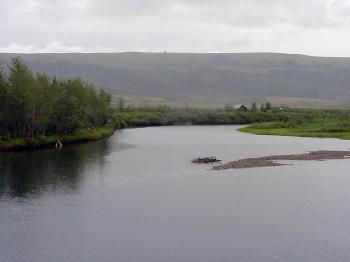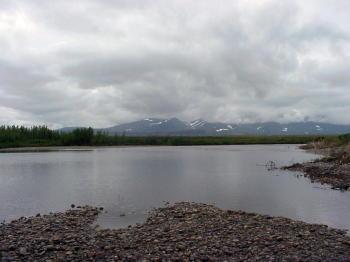
|
|
13 July, 2002
Before I leave Nome to board the Healy, I want to add
a few more observations about this wonderful area.
These are in no parcticular order.
When I came into Nome on the first day, I met Jack, a
teacher from White Mountain. Jack is the only science
teacher in the high school of 15 students! He teaches
one subject to all 15 each year; this year it will be
biology. By the time the students graduate, they will
each complete four years of science.
On Friday, we went out on one of the Nome roads.
There are approximately 250 miles of roads, mostly
unpaved but well maintained, in the Nome road system.
Two of the three main roads end at a small settlement,
the other just ends. As we headed out to the Pilgrim
River where Taylor and Banner wanted to fish, we
spotted muskoxen on a hill in the distance. We parked
the truck and hiked to the top of the hill where we
were able to get close enough to identify more than 25
muskox enjoying an afternoon rest. The muskox is the
only surviving member of a large group of ice-age
“oxen” that are all now extinct. As the only High
Arctic mammal that does not seek shelter during winter
blizzards, they are incredibly well adapted to this
harsh climate. Their outer coat of coarse guard
hairs, reaching nearly to the ground, covers an inner
layer of thick, soft, fleecy, extremely fine wool
which the Inuit call quiviut. Interestingly enough,
the muskoxen were re-introduced here and have been
very successful without disturbing the natural
ecosystem.
On our walk up the hill, we passed many beautiful
tundra plants (and two piles of bear scat). All are
adapted to the short growing season with limited
sunlight. The Arctic Poppy (Papaver radicatum), for
example, turns constantly to face the sun. This
allows the flower to become much warmer that the
surrounding air, offering a hospitable landing site
for potential pollinators!
In the picture taken at the Pilgrim River, you will
see cottonwood trees, an uncommon sight on the tundra
since trees are generally not seen here. If you think
about what plants need to grow, it’s easy to see why.
Plants use photosynthesis (photo means light and
synthesize means to build) to collect the sun’s energy
in order to make food. Although there is plenty of
sunlight during the arctic summer, photosynthesis
cannot happen unless the plant is warm enough. With
such a short time when both sunlight and warmth are
available, the plant needs to use all its energy to
make new leaves and to store food for the long winter
months. A plant simply does not have the energy to
grow tall. Another factor that limits tree growth is
the depth of the permafrost (permanently frozen
ground). A tree’s height is limited by the soil which
supports its roots.
Although the boys were fishing, I would not have been
allowed to get a permit if I had asked. Only those
who live here can fish right now, and they must fish
on a subsistence level. That means they must eat all
they catch. The fish population has dropped
substantially over the last few years, and fishing is
being strictly regulated. There is no identified
reason for the decline, but most feel it is related to
warmer ocean temperatures. Many of the game fish are
ocean fish which return to these waters to spawn.
Although we spent an hour at the river, we spotted
only a few red salmon and one or two arctic graylings
in an area that would have been teeming with fish only
a decade ago. The ocean warming may be something new
or it may be a part of what seems to be a natural
cycle of ups and downs in the fish population.

One view along the Pilgrim River, a stop on one of the Nome roads. This road does not end at any place in parcticular; it just ends.

Another view from the opposite side of the bridge over the Pilgrim River
Contact the TEA in the field at
.
If you cannot connect through your browser, copy the
TEA's e-mail address in the "To:" line of
your favorite e-mail package.
|
